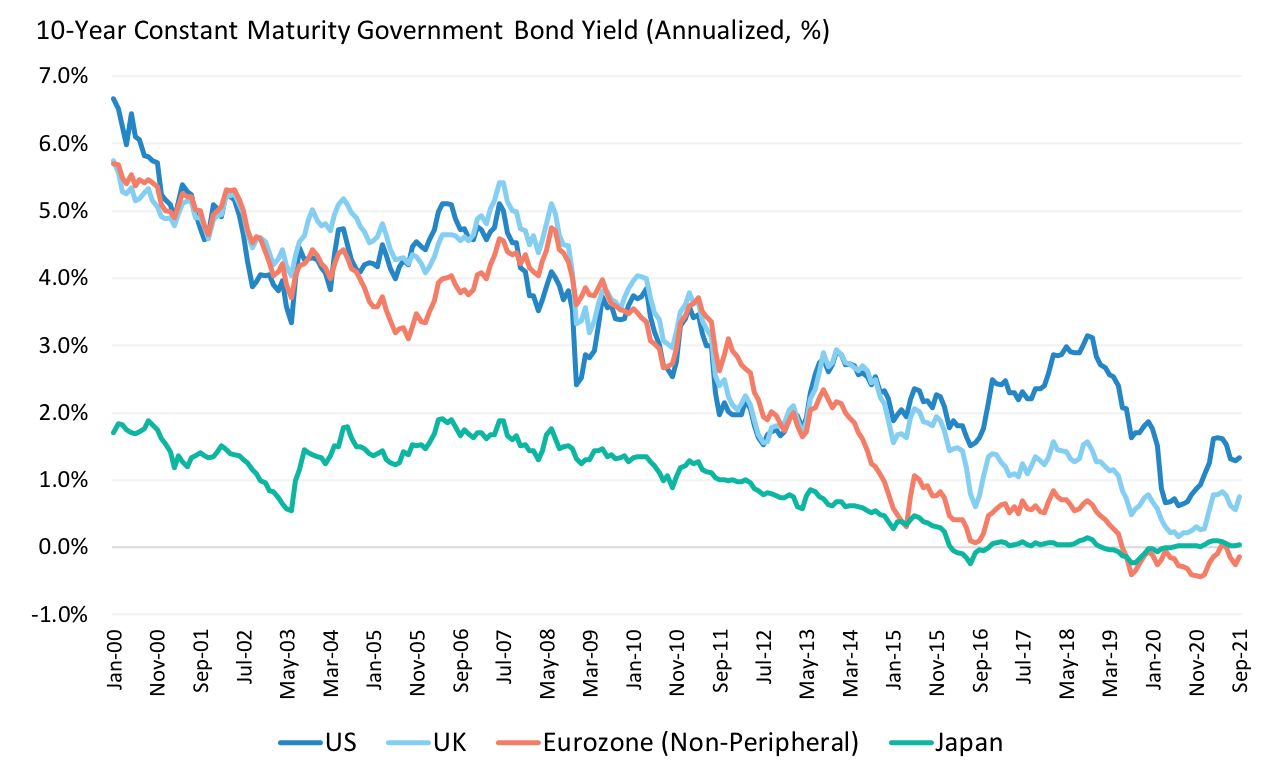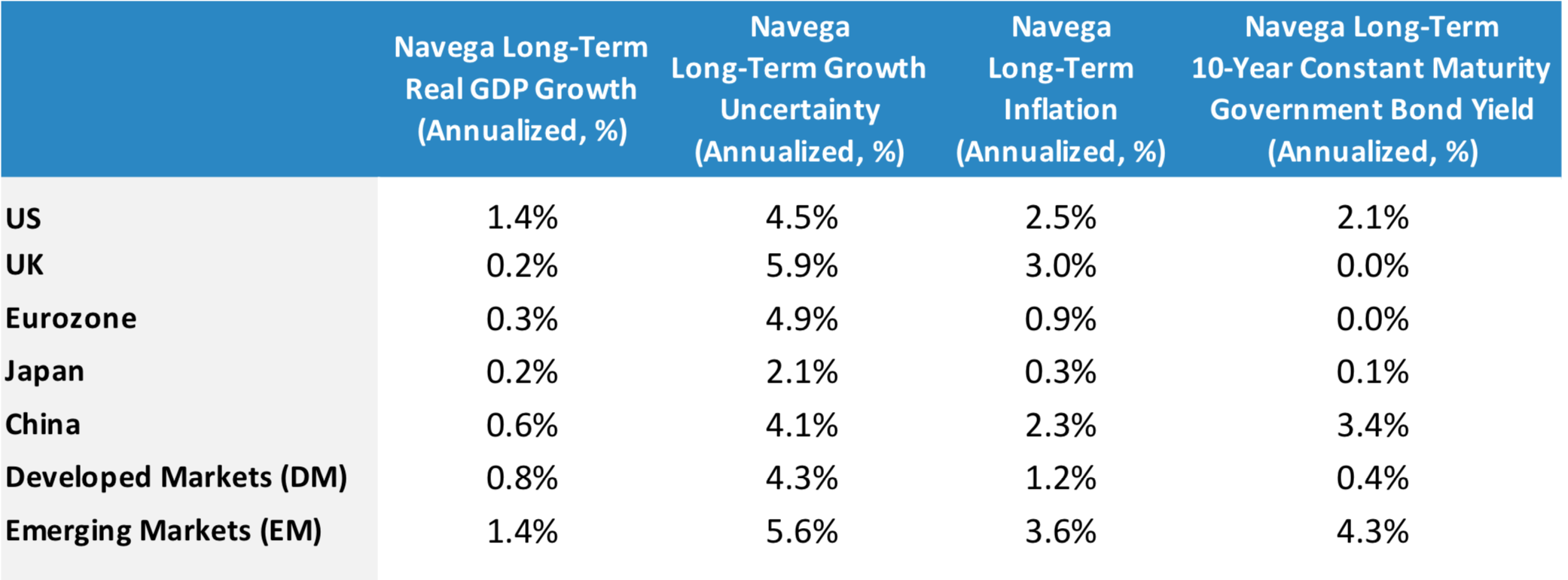
Despite the past year’s improvements in real GDP growth rates and upticks in inflation, our models suggest that nominal interest rate expectations are likely to remain low for longer. In our models, the main driver of low nominal rates is the persistence of low real growth and increased long-term growth uncertainty. That said, investors seeking clues about future central bank decisions should focus on the risk of higher nominal interest rates, driven by increased upside risks to inflation.

Exhibit 1 shows that 10-year government bond yields in the US, UK, Eurozone, Japan have been decreasing on trend since 2000, with salient declines following each major economic crises (2002, 2008 and 2020-21). These trends are not surprising from our perspective. Indeed, according to our models, the primary driving forces behind this continuous decline in bond yields have been declining long-term expectations of real GDP growth and inflation. The growth and inflation trends have in turn been largely driven by continues declines in total factor productivity (TFP) growth and labor force growth . Moreover, increased levels of long-term growth (macro) uncertainty following the GFC and the pandemic have further added to the decline, as investors demand insurance against (negative) shocks to growth in the form of government bonds.
What next for the future path of interest rates? This path depends on the paths of the long run drivers of interest rates: expectations of long-term real economic growth – in turn driven labor force and TFP growth – long-term growth uncertainty, and long-term inflation. Let us examine our baseline scenario for each of these driving factors and their sources in sequence. As discussed in our previous note, global long-term growth prospects still look anemic, according to our models, despite past year’s continuous improvements in quarterly real GDP growth rates. Indeed, the labor force of major economies is likely to grow slower than historical average, given the demographic pressures experienced by these economies due to the aging of their population. As for total factor productivity, its long-term growth prospects remain muted, according to our models. Our previous note also showed that the level of long-term growth uncertainty induced by the pandemic remains high, globally. Finally, long-term inflation expectations have barely changed and remain at rather low and benign levels, despite this year’s upticks and jitters considered temporary in their nature by major central banks. Taken together, and as shown in Exhibit 2, our baseline view is that interest rates are also likely to remain low for longer, worldwide.

Perhaps a better question for investors is what set of macro conditions could be consistent with a rise treasury yields, back to, say, the levels that prevailed before the 2008 GFC? For example, a possible scenario could be that, given current expectations of long-term growth and growth uncertainty, high inflation risk ends up materializing into higher inflation expectations to help sustain ballooning debt-to-gdp ratios. Nominal rates would increase in this scenario even though real rates would be unchanged.
Alternatively, regulatory changes (such as anti-trust laws that increase competition) and directed technological innovations could combine to increase long-term TFP growth and long-term real GDP growth, and bring macro uncertainty back to its pre-pandemic level. If inflation expectations are unchanged, then nominal rates would increase because real rates had increased.

Focusing on the US, Exhibit 3 uses our model to show the impact on US 10-year Constant Maturity Treasury yields under our baseline scenario and two alternatives. According to the Exhibit, 10-year treasury yields could reach their pre-2008 GFC level of about 4.3% if on average over the next 10 years, inflation expectations increase to 4.6% (annualized) compared to their current baseline level of 2.3%. The same yield level could be reached if macro uncertainty narrows down (to 3% from 4.5% per year) around higher long-term growth expectations of 2.8% (annualized) as compared to the current baseline level of 1.5%. Interestingly, according to our models, these were also the macro conditions that prevailed pre-2008 GFC .
The main takeaway from these results is that investors should focus on the long-term drivers of real growth rather than nervously looking for clues about the future path of interest rates in central bank meeting minutes and short-term fluctuations in jobs and inflation rates. They should systematically evaluate alternative scenarios for the main drivers of long-term growth (e.g., TFP growth and labor force growth) and then assess the impact of these scenarios on the future path of rates.
Secular trends in demographics and TFP growth place limits on long-term prospects for growth, bar any effective policy that would help mitigate their impact. Combined with acutely high levels of macro uncertainty, real bond yields are likely to remain low for longer. And with long-term inflation expectations projected to remain benign (despite the fiscal largess) nominal bond yields are also likely to continue to remain low. However, high levels of inflation risk induced by high macro uncertainty should not be overlooked - this risk could well feed sudden, unpredictable increases in expected and realized inflation rates, and in turn, nominal yields.
This document is for informational purposes only. This document is intended exclusively for the person to whom it has been delivered, and may not be reproduced or redistributed to any other person without the prior written consent of Navega Strategies LLC (“Navega”). The information contained herein is based on Nageva’s proprietary research analytics of data obtained from third party statistical services, company reports or communications, publicly available information, or other sources, believed to be reliable. However, Navega has not verified this information, and we make no representations whatsoever as to its accuracy or completeness. Navega does not intend to provide investment advice through this document. This document is in no way an offer to sell or a solicitation of an offer to buy any securities. Investing in securities involves risk of loss, including a loss of principal, that clients should be prepared to bear. Past performance is not indicative of future results, which may vary materially. While this summary highlights important data, it does not purport to capture all dimensions of risk. The methodology used to aggregate and analyze data may be adjusted periodically. The results of previous analyses may differ as a result of those adjustments. Navega has made assumptions that it deems reasonable and used the best information available in producing any calculations herein. Statements that are nonfactual in nature, including opinions, projections and estimates, assume certain economic conditions and industry developments and constitute only current opinions that could be incorrect and are subject to change without notice. All information provided herein is as of the delivery date the document (unless otherwise specified) and is subject to modification, change or supplement in the sole discretion of Navega without notice to you. This information is neither complete nor exact and is provided solely as reference material with respect to the services offered by Navega. Information throughout this document, whether stock quotes, charts, articles, or any other statement or statements regarding market or other financial information, is obtained from sources which we and our suppliers believe reliable, but we do not warrant or guarantee the timeliness or accuracy of this information. The information presented here has not been personalized, and is not based on the financial circumstances of the recipient. This information may not be applicable to your particular financial needs, and should not, by itself, be used to make determinations regarding the purchase or sale of securities, or other investment decisions.
The model performance information presented is based on the application of Navega’s factor analysis, backtested against actual historical data. “Backtesting” is a process of objectively simulating historical performance information by applying a set of rules backward in time. The results of the application of Navega’s model do not reflect actual performance or actual historical data. Such models are prepared with the full benefit of hindsight, and it is not likely that similar results could be achieved in the future.
The model portfolios were constructed by Navega with the benefit of hindsight to illustrate certain performance metrics. The performance shown was not actually achieved by any investor. The investments in these hypothetical portfolios were selected with the full benefit of hindsight, after performance over the period shown was known. It is not likely that similar results could not be achieved in the future. The hypothetical portfolios presented here are purely illustrative, and representative only of a small sample of possible scenarios.
The projections shown do not represent actual performance, and are based on assumptions which may not occur. It is possible that the markets will perform better or worse than shown in the projections, the actual results of an investor who invests in the manner these projections suggest will be better or worse than the projections, and an investor may lose money by relying on these projections.